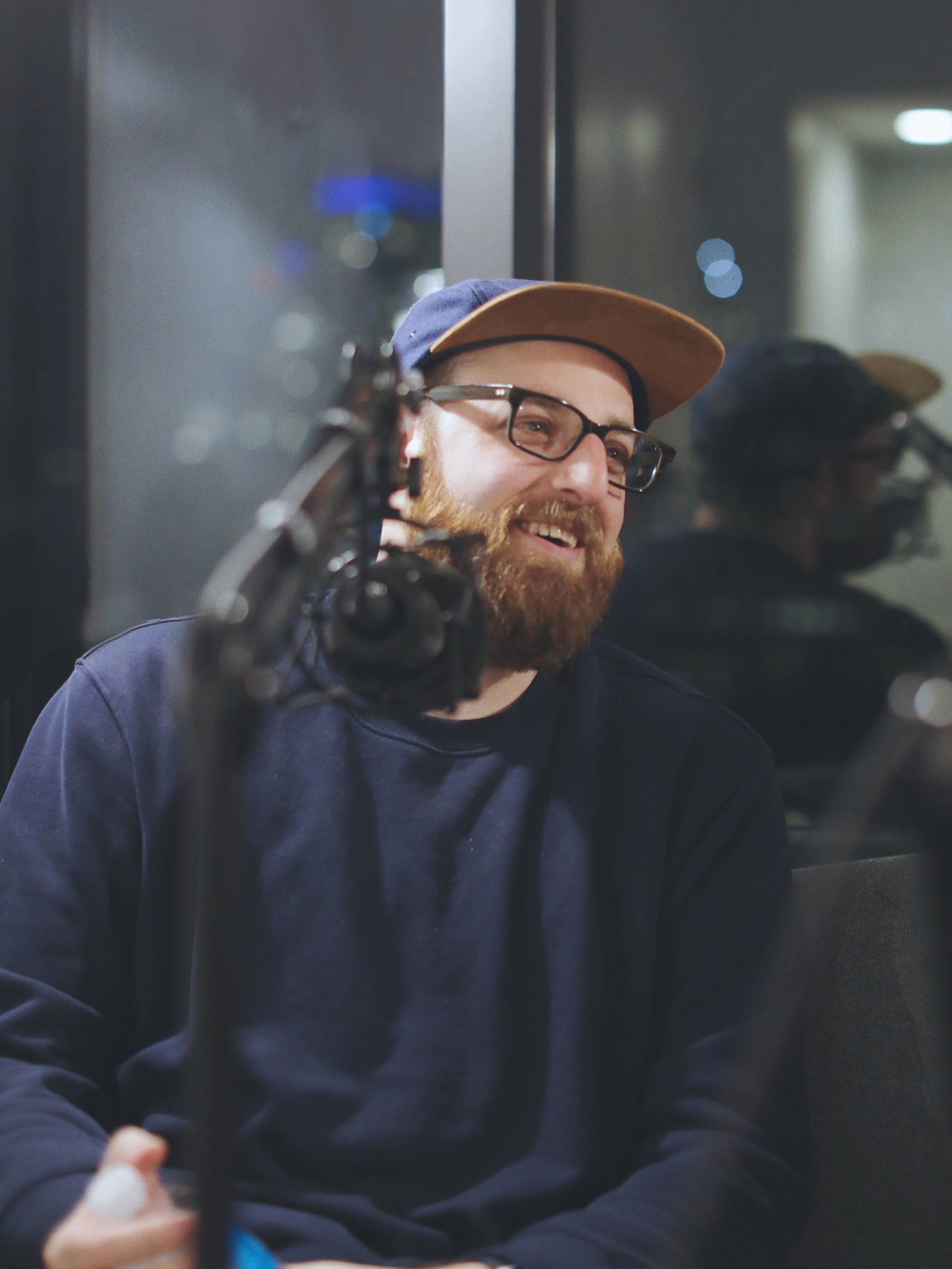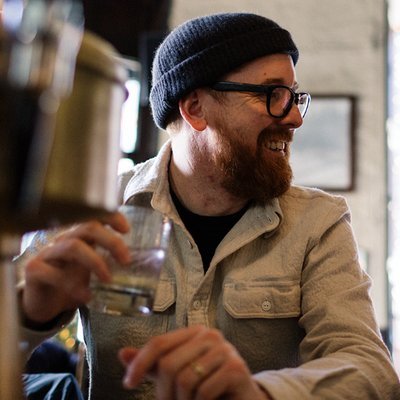Two Punk Rock Dad Designers Discuss Their Prolific Creative Careers
Dave Brown has worn many hats in his design career. Image: c/o Dave Brown
Hot pizza and cold beer. That’s a promising start to anything, whether it’s a meal or an interview. And so began both on a summer Friday afternoon in Williamsburg, Brooklyn when Dave Brown, Head of Creative at Square, and Dave Snyder, Senior Director, Product Design at Slice, sat down at Leo for a conversation about their creative careers. With Dave Snyder in the pizza business, we naturally had to pick a spot that served excellent pies; Leo’s San Guiseppe (tomatoes, spicy sausage, onions, olives, provolone) and clam (clams, cream, garlic, chili, parsley, pecorino) did not disappoint!
Between the two of them, Dave Snyder and Dave Brown have worked at Square, Microsoft, Amazon, Twitter, Firstborn and Slice, in leadership positions designing many of the products we use every day. As they learned when they met in person for the first time, they share an entrepreneurial spirit and a love for punk rock DIY music that helped define their creative pursuits.
This whole idea of getting together was pitched to them via Twitter DM: The two of them have had parallel career paths with fascinating twists and a unique perspective on how the world of design has evolved over the past 20 years. Over the course of lunch, they discussed the biggest bets they made on themselves, what makes a great leader, the most punk rock thing they’ve done, and advice they’d give their younger selves. Here is an edited version of that conversation.
“If I ever write a book, it would be called, Everything I Learned About Business, I Learned From Skateboarding.”
Dave Snyder, left. Image c/o Dave Snyder
MM: Have your careers played out as you thought they would?
DS: There's a meme that comes to mind that shows a career journey of a designer: It's like you start off wanting to do cool stuff and then you go through this period where you’re all about saving the world. I'm at the point again where I just want to make cool stuff. Of course it's providing value, but I don’t have much energy for drama and bureaucracy. I’m leaning towards making things that make people happy. When I started, I went to school for business because I felt like I had to and when I got into the industry in the late ‘90s there was no such thing as digital anything. I learned to code–it was almost like a hobby I could use to make money. It was driven by passion.
DB: I don't think I've ever been a person with a five-year plan. When I started my first company, I never wrote a business plan. I never went to design school. I taught myself every program because I was excited by the possibilities of them. And it's still that way. Growing up in the punk rock scene, I always kind of felt like I was an outsider. So I have always been intentional about hiring people that didn't come from the norm. And I try to work with indie agencies that are just starting so they can flourish. Some of the best, most fulfilling parts of my career is being able to leverage the resources of these massive companies that I've had the luxury of working for and giving it to the small guy.
DS: It's the best of punk rock: Skateboarders supporting skateboarders. When I worked on a campaign with adidas, we got to hire the local legend Giovanni Retta to shoot the videos and photos. I wanted to work with him and we did. I definitely have thought, if I ever write a book, it would be called, Everything I Learned About Business, I Learned From Skateboarding.
MM: Dave, you mentioned that some younger designers reached out to you this week seeking your counsel about where things are going in the industry and how they might move on that. What did you tell them?
DS: It was just more sharing past experiences that I've gone through and what made me feel weird at certain points, like hard decisions when I left Firstborn. I had to fall on my sword to save 50 people's jobs. I did that in a punk rocker way. Holding companies don’t tell you they want to lay off 50 people. They give you a target number and, at that time, the number made it very clear what they wanted us to do. Despite us winning all kinds of business back then, we were at the beginning of COVID and everyone was freaking out.
I remember going to this meeting with the CEO of the company Firstborn rolled up into (think holding companies inside holding companies). And I’m like, ‘the problem is not the people who push the pixels and write the words. The problem is all of you who are in the middle.’
What needed to go was their lack of value and associated salaries, not my team of designers, writers and engineers, and if they are going to do layoffs they can start with me.
MM: That is very punk rock. Dave Brown, what’s the most punk rock thing you've done in your career?
DB: Probably starting a record label, and a lot of entrepreneurial ventures.
The obligatory lunch photos, a pair of delicious pizzas. Images c/o Dave Brown and Dave Snyder
MM: You started your career building your own companies–notably Holiday Matinee, which you still run today–before moving on to a number of iconic tech companies. What led you to start your own companies?
DB: I didn't want to work for anyone. I was listening to the Beach Boys—wouldn't it be nice?—one day while working at Mailboxes, etc. I had just moved from New York to San Diego and I was 22, just graduated college. I couldn't afford grad school so I was spending a year to get in-state residency. At the time, I was making fanzines and touring with bands and I decided to start my own businesses around my passions, including an art gallery and a record label. I was in my 20s and I knew nothing, making mistake after mistake. I was living in a closet basically, so my expenses weren't high. Then the internet broke things open. I could connect with other people who have similar ideas and passions.
MM: What did you learn about yourself as an entrepreneur?
DB: I put in the work. If I didn’t know how to do something, I’d spend hours reading how to do it. And then I learned how to use the design tools. I had the energy and drive to sit there and grind for 14 hours a day on the thing I thought was cool.
One night Jimmy Eat World came to town to play a show and only like five of us were there. So the band came back to my house afterwards and we were hanging out and Jim, the singer, and I were drinking beers and he showed me some photographs he had taken on the road on tour, beautiful photographs. He said they were going to put out an EP and I’m like, let me scan these–I had a giant flatbed scanner and it took minutes to scan. I started mucking around and designed Jimmy Eat World’s new record cover right then and there. That's how it felt like it should happen back then.
MM: Dave S., what’s the biggest bet you’ve made on yourself?
DS: I moved from Denver, where I lived at the time, to New York City at the beginning of the Great Recession in 2008 to work at Firstborn. I had no contacts, no family, nothing here. My wife still worked for a company in Colorado at the time. I came here on a hunch–sometimes you have just to go with your gut.
MM: Whether you’ve worked for start-ups, big companies, or your own ventures, you both have entrepreneurship in your blood. What impact has that mindset had on your creative life?
DS: It’s helpful for when you communicate with leaders at your company. You understand the language that’s spoken and how decisions are made. Get experience in a lot of different business units and disciplines, so you can learn the business. It's helped me sell through internal ideas way more.
DB: What's great about being an entrepreneur is that it forces you to learn a lot of different things really fast. It’s like at an agency when you get an incomplete brief and aggressive timeline on a project. I’ve learned how to wear many hats. I've forced myself to understand accounting, marketing, product design, software, hardware, HR…
MM: Creativity demands a little bit of courage. What’s a memorable creative risk you took and how did it go?
DBOne of the biggest risks I took was in 2001 as I was about to embark on the Holiday Matinee Winter Tour, a month-long tour for three bands I worked with at the time (Death Cab For Cutie, The Jealous Sound and The And/Ors). I had a sponsor lined up who was going to fund the tour but in the 11th hour, they went bankrupt and so I threw my credit card down to cover all the expenses (van rentals, marketing, merch, gas, tire blowouts, etc). It took a few years to pay that off but to this day, it was one of the best experiences of my life.
MM: What are the qualities of a good leader, and how do you become one?
DS: I think great leaders are excited about the unknown future—they have a vision of where things should go and allow the team to find the way towards it. They tend to be comfortable being uncomfortable and that, in turn, gives confidence to others on the journey. I should note that this aspect of leadership has little to do with rank or title. In the design space specifically I would say there needs to be a love for the craft itself. As a leader, especially as you get into the management end of the leadership spectrum, you want to nurture that love of craft in your team and give them the tools, mentorship, and S P A C E to do the things you hired them to do.
DB: “Curiosity is the gateway to everything in life.” I haven’t a clue who said that but f*ck yeah double-tap that sh*t. And you get to that place through experience. The best leaders put people first. Everything rises and falls on how you lead your team, and keeping people happy is a pretty important part of keeping them productive. And a great way to become a good leader is to shift from, “how’s everything going?” to “what’s one thing that could be better?”
What's your advice for a 23-year-old punk rock designer these days?
DS: If you're 23, you've got so much time. Explore until it starts feeling real at around 30 You've got plenty of time to explore. Whatever you try, make sure you stick it out long enough to actually make a difference. The first three first six months of a job are easy. It takes more than a year before you really get into a groove and see impact.
DB: I'd also say get that money. It will open doors of opportunity for you to make an impact on other folks so they can get to that place.
If you’d like to read more from The Creative Factor, sign up for our newsletter.
Plus, check out the following pieces:



